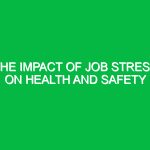In today’s fast-paced world, the importance of balancing work and life to reduce stress cannot be overstated, especially within the Health, Safety, and Environment (HSE) domain. Employees often juggle multiple responsibilities, leading to increased stress levels that can adversely affect both personal well-being and workplace safety. This article delves into the significance of achieving a work-life balance, the potential hazards associated with neglecting this balance, and practical strategies to mitigate stress while adhering to HSE standards.
The Importance of Balancing Work and Life in HSE
Balancing work and life is not merely a personal aspiration; it is a fundamental requirement for fostering a safe and productive work environment, particularly in industries where safety is paramount. In HSE, where the stakes involve both human health and environmental protection, stress can lead to poor decision-making, increased accident rates, and reduced compliance with safety protocols. For instance, a construction site manager who is overwhelmed with work might overlook critical safety checks, putting workers’ lives at risk. Therefore, it is essential to recognize that a well-balanced lifestyle is vital not only for individual health but also for the collective safety of the workforce.
Defining Work-Life Balance
Work-life balance refers to the equilibrium between professional responsibilities and personal life. It encompasses how individuals allocate their time and energy between work commitments and personal interests or family time. Achieving this balance allows for a more fulfilling life, reduces stress, and enhances overall productivity. In the HSE context, it means that safety professionals can focus on their duties without the hindrance of personal stressors, which can cloud judgment and lead to unsafe conditions.
Potential Hazards and Risks of Poor Work-Life Balance
Neglecting work-life balance can result in various hazards and risks, especially in the HSE sector. Here are some of the key issues:
1. Physical Health Risks
Chronic stress is a silent killer. Prolonged exposure to stress can lead to serious health issues such as hypertension, heart disease, and other stress-related ailments. For instance, an employee working excessive hours may neglect their physical health, skipping meals and exercise, which can lead to fatigue and decreased alertness on the job. This is particularly dangerous in environments that require high levels of concentration and physical stamina.
2. Mental Health Risks
Beyond physical health, mental well-being suffers when work-life balance is skewed. Anxiety, depression, and burnout are prevalent among professionals who find it challenging to disconnect from work. According to a report from the World Health Organization (WHO), employee burnout has become a critical issue, impacting not only individual health but also organizational productivity.
3. Increased Accidents and Incidents
In safety-sensitive industries, fatigue and mental strain can lead to negligence and errors. Research shows that individuals working beyond standard hours are more likely to make mistakes that could result in workplace accidents. For example, a safety officer overwhelmed with paperwork might skip crucial inspections, placing workers in harm’s way.
Best Practices for Balancing Work and Life
To mitigate the hazards associated with work-life imbalance, employees and employers can adopt several best practices. These strategies aim to foster a healthier work environment while maintaining compliance with HSE standards.
1. Establish Clear Boundaries
Setting boundaries between work and personal life is crucial. Employees should communicate their working hours clearly to colleagues and supervisors. For instance, a project manager might establish a policy where emails sent after hours will be addressed the next business day. This practice not only helps prevent burnout but also cultivates a culture of respect for personal time.
2. Promote Flexible Work Arrangements
Many organizations are now adopting flexible work policies, allowing employees to adjust their hours or work remotely. This flexibility can significantly reduce stress levels. For example, a safety engineer might choose to work from home on certain days, allowing them to manage family responsibilities while still fulfilling work obligations. Such arrangements can lead to increased job satisfaction and productivity.
3. Prioritize Self-Care
Encouraging self-care is vital for employees in high-stress environments. Simple practices like regular exercise, meditation, and adequate sleep can improve overall health. A case study from a manufacturing company found that implementing wellness programs significantly reduced employee absenteeism and improved morale. Investing in employee well-being pays off in the long run.
4. Foster Open Communication
Creating an environment where employees feel comfortable discussing their stressors is essential. Regular check-ins between management and staff can help identify and address potential issues before they escalate. For example, a weekly team meeting dedicated to discussing workload and stress management can facilitate this open dialogue, allowing for a collective approach to problem-solving.
Regulations and Standards Governing Work-Life Balance in HSE
Various regulations and best practices exist to promote work-life balance and employee well-being in the HSE domain. Understanding these guidelines is crucial for both employers and employees.
1. Occupational Safety and Health Administration (OSHA)
OSHA provides standards for workplace safety, emphasizing the need for employers to create a safe work environment. While OSHA does not directly address work-life balance, promoting a culture of safety through stress management and work-life policies aligns with their goals.
2. The National Institute for Occupational Safety and Health (NIOSH)
NIOSH advocates for a holistic approach to worker health, which includes mental health initiatives. Their research highlights the importance of addressing stressors in the workplace as part of an effective health and safety program.
3. ISO 45001
The ISO 45001 standard focuses on occupational health and safety management systems. It encourages organizations to improve their safety performance by addressing worker well-being, which inherently includes aspects of work-life balance. Compliance with this standard can help organizations create safer, healthier work environments.
Conclusion
Balancing work and life to reduce stress is not just a personal endeavor; it is a critical component of promoting health and safety in the workplace, particularly in HSE sectors. The risks associated with poor work-life balance can have far-reaching consequences, impacting individual health and organizational performance. By implementing best practices, promoting open communication, and adhering to relevant regulations, both employees and employers can create a safer, more productive work environment. In this way, achieving a sustainable work-life balance becomes not just a goal but a necessity for fostering a culture of health and safety.


